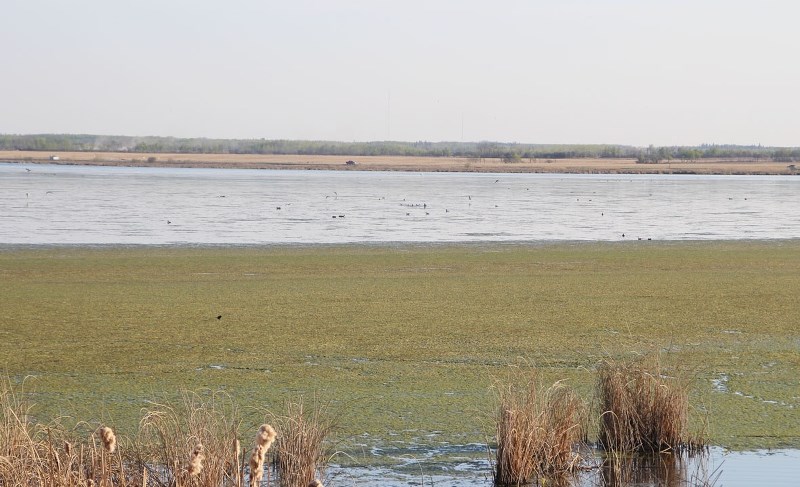The question of what's causing that pungent smell in Bonnyville throughout the spring and summer has been answered, it's Jessie Lake.
The question of what's causing that pungent smell in Bonnyville throughout the spring and summer has been answered, it's Jessie Lake.
What local residents have long suspected has finally been proven by the Lakeland Industry and Community Association's (LICA) Portable Air Monitoring System (PAMS). Situated at the Alberta Energy Regulator (AER) office north of the lake for the past year, the device recorded Jessie Lake emitting high levels of hydrogen sulphide gas.
"You didn't need to monitor the air quality to know that Jessie Lake smells, but now we have some numbers to quantify the odour," said Michael Bisaga, manager of the LICA airshed environmental monitoring program. "It was predictable, but now we know for certain. In the months where the lake is ice-free, the spring and summer, we had high hydrogen sulphide levels, which is a gas that has a characteristically rotten egg odour to it."
The PAMS is used to measure air quality in areas where LICA doesn't have a permanent monitoring station. Deployed in Bonnyville in 2016, the station operates 24-hours a day, seven days a week. Drawing air from the outside into the station, the instruments analyze the air for different compounds that are present.
"We decided to move it to Bonnyville because it's the next most populated centre after Cold Lake, also there's historically been these odours that come from Jessie Lake that we haven't had any data on to understand what's causing this odour," noted Bisaga.
The PAMS found that, overall, concentrations of air pollutants measured were comparable to those observed in Cold Lake. However, the one air quality parameter that was off was 'smell.' The station recorded an unusually high number of exceedances of the Alberta Ambient Air Quality Objective (AAAQO) for hydrogen sulphide. The objective set for hydrogen sulphide is rarely exceeded, even in larger cities or areas with heavy industry.
Near Jessie Lake, over 120 exceedances were recorded between June and October
The AAAQO objective for hydrogen sulphide over one-hour is 10 parts per billion (ppb). LICA found the maximum one-hour concentrations measured by the PAMS were in the 30 to 40 ppb range. Despite being higher than the ideal level, it's still significantly lower than the 1,000 to 20,000 ppb range where adverse health effects occur.
It isn't until the hydrogen sulphide reaches a one-hour reading of 500,000 to one million ppb that fatal exposure can occur.
"They're not necessarily at a level that is considered to be a health risk, it is considered to be an odour nuisance. People might be annoyed by the odour but it's not necessarily causing a health impact," said Bisaga.
Analysis of the wind direction, coming predominately from the south and south-west, further supported that the odour is coming off of Jessie Lake. What's believed to be causing the local water body to emit such a strong odour is the vegetation or other organic material in it that's decaying.
"It's particularly bad in the spring because that decay continues to happen over the winter months, but there's a sheet of ice over top of the lake that's preventing it from being released. Once it's ice-free, a bunch of the hydrogen sulphide gas is released when it thaws and warms up in the spring," explained Bisaga, noting that it goes through cycles.
"The readings are highest immediately after the lake thaws. Throughout the summer, they tend to go down and by the fall, as it cools off even before the ice appears, we see it taper off to nothing."
Now that they know what's causing the offensive smell, the hope is LICA can find a solution to finally provide residents' senses some relief.
With only one year of monitoring to go off of, the data is still considered to be preliminary and monitoring will be continued. The PAMS is now being moved to the south side of the lake to record the hydrogen sulphide concentrations in that area. Since the issue of frequent hydrogen sulphide from an "open area source" is new to LICA, they will also be meeting with their partners to discuss what can be done to mitigate the smell at Jessie Lake.
"We're going to meet with the watershed stakeholders who are interested in the water quantity and quality. There might be some other measurements within the lake that can be done, such as aquatic or other monitoring activities that will help understand the conditions in the lake that lead to these odour releases," Bisaga said. "The other thing we'd like to do is work with the partner agencies and organizations to see what can be done to manage the odour issues."
While there's still some work to be done and further monitoring taking place, the results can finally put to rest the question of what's causing that smell in Bonnyville.
